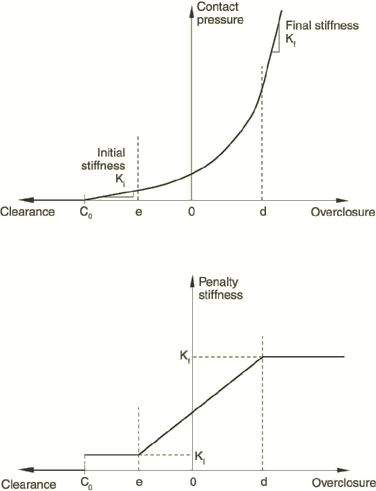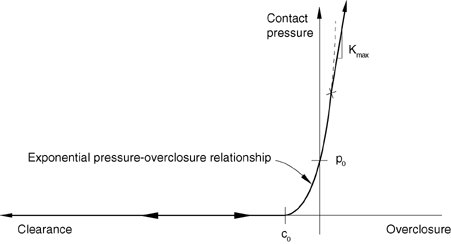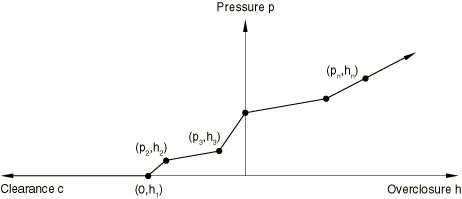ProductsAbaqus/StandardAbaqus/ExplicitAbaqus/CAE
TypeModel data in Abaqus/Standard; Model or history data in Abaqus/Explicit
LevelPartPart instanceAssemblyModel in Abaqus/Standard; Step in Abaqus/Explicit
Abaqus/CAEInteraction module
Optional, mutually exclusive parameters
- AUGMENTED LAGRANGE
This parameter applies only to Abaqus/Standard analyses with a default “hard” pressure-overclosure relationship.
Include this parameter to choose the augmented Lagrange method for enforcement of the contact constraint. See Contact constraint enforcement methods in Abaqus/Standard for a discussion of the default penalty stiffness and penetration tolerance associated with this method (the default penalty stiffness used by this method is often stiffer than that with the straight penalty method). You can specify or modify the penalty stiffness on the data line.
- DIRECT
This parameter applies only to Abaqus/Standard analyses.
Include this parameter to choose direct enforcement of contact constraints without approximation or use of augmentation iterations.
- PENALTY
This parameter applies only to Abaqus/Standard analyses with a default “hard” pressure-overclosure relationship.
Set PENALTY=LINEAR (default) to choose the linear penalty method for enforcement of the contact constraint. See Contact constraint enforcement methods in Abaqus/Standard for a discussion of the default linear penalty stiffness. You can specify or modify the penalty stiffness on the data line.
Set PENALTY=NONLINEAR to choose the nonlinear penalty method for enforcement of the contact constraint. See Contact constraint enforcement methods in Abaqus/Standard for a discussion of the default nonlinear penalty stiffness. You can specify or modify the final nonlinear penalty stiffness and other nonlinear penalty control parameters on the data line.
![]()
Optional parameters
- NO SEPARATION
Include this parameter to prevent any separation of the two surfaces once contact has been established.*CLEARANCE
- PRESSURE-OVERCLOSURE
Use this parameter to choose a contact pressure-overclosure relationship other than the default hard contact.
Set PRESSURE-OVERCLOSURE=HARD (default) to choose a pressure-overclosure relationship without physical softening. Note that some numerical softening will occur if a penalty or augmented Lagrange constraint enforcement method is used.
Set PRESSURE-OVERCLOSURE=EXPONENTIAL to define an exponential pressure-overclosure relationship.
Set PRESSURE-OVERCLOSURE=LINEAR to define a linear pressure-overclosure relationship.
Set PRESSURE-OVERCLOSURE=SCALE FACTOR to define a piecewise linear pressure-overclosure relationship based on scaling the default contact stiffness. This option is available only for the general contact algorithm in Abaqus/Explicit.
Set PRESSURE-OVERCLOSURE=TABULAR to define a piecewise linear pressure-overclosure relationship in tabular form.
Set PRESSURE-OVERCLOSURE=HERTZ to define a Hertz-type pressure-overclosure relationship for discrete element method analysis.
Set PRESSURE-OVERCLOSURE=JKR to define a JKR-type pressure-overclosure relationship for discrete element method analysis.
If a contact area is not defined, such as may occur for node-based surfaces or for GAP- or ITT-type contact elements, “pressure” should be interpreted as force. For contact with three-dimensional beams or trusses, “pressure” should be interpreted as force per unit length.
When used to modify the default surface behavior, the PRESSURE-OVERCLOSURE parameter cannot be used with the NO SEPARATION parameter in an Abaqus/Standard analysis.
![]()
Optional data line for AUGMENTED LAGRANGE and PENALTY=LINEAR
- First (and only) line
User-defined linear penalty stiffness. If this field is left blank or is zero, the linear penalty stiffness has the default value or is multiplied by the scale factor given in the third field of the data line.
Clearance at which the contact pressure is zero, . The default is zero.
Scale factor for the default linear penalty stiffness or for the linear penalty stiffness if specified in the first field of the data line. The default is one.
![]()
Optional data line for PENALTY=NONLINEAR
- First (and only) line
User-defined final nonlinear penalty stiffness. If this field is left blank or is zero, the final nonlinear penalty stiffness has the default value or is multiplied by the scale factor given in the third field of the data line.
Clearance at which the contact pressure is zero, (see Figure 1). The default is zero.
Scale factor for the default final nonlinear penalty stiffness or for the final nonlinear penalty stiffness if specified in the first field of the data line. The default is one.
Scale factor for the upper quadratic limit (see Figure 1), which is equal to the scale factor times the characteristic contact facet length. The default is 0.03.
The ratio of initial penalty stiffness over the final penalty stiffness. The default is 0.01.
The ratio (−)/(−) that defines the lower quadratic limit (see Figure 1). The default is 1/3.
![]()
Data line for PRESSURE-OVERCLOSURE=EXPONENTIAL
- First (and only) line
Clearance at which the contact pressure is zero, (see Figure 2).
Pressure at zero clearance, .
- The following data item is available only in Abaqus/Explicit analyses:
Value of the maximum stiffness, . When using penalty contact, large stiffness values obtained from the exponential law may significantly lower the stable time increment size. Choose a suitable maximum stiffness to mitigate this effect (see Figure 2). By default, is set equal to infinity for kinematic contact and the default penalty stiffness for penalty contact.
![]()
Data line for PRESSURE-OVERCLOSURE=LINEAR
- First (and only) line
Slope of the pressure-overclosure curve. This value must be positive.
![]()
Data line for PRESSURE-OVERCLOSURE=SCALE FACTOR
- First (and only) line
Overclosure factor, (see Figure 3), which defines the overclosure measure (used to delineate the segments of the pressure-overclosure curve) as a percentage of the minimum element size in the contact region. This value must be greater than zero. Leave blank if an overclosure measure (second data item) is specified.
Overclosure measure, (see Figure 3), which defines the overclosure measure (used to delineate the segments of the pressure-overclosure curve) directly. This value must be greater than zero. Leave blank if an overclosure factor (first data item) is specified.
Stiffness scale factor, (see Figure 3), which defines the geometric scaling of the “base” stiffness and must be greater than one.
Initial stiffness scale factor, (see Figure 3), which defines an additional scale factor for the “base” default contact stiffness and must be greater than zero. The default value is one.
![]()
Data lines for PRESSURE-OVERCLOSURE=TABULAR
- First line
Pressure.
Overclosure.
Repeat this data line in ascending order of overclosure value as often as necessary to define the overclosure as a function of pressure. A minimum of two data lines are required. The pressure-overclosure relationship is extrapolated beyond the last overclosure point by continuing the same slope (see Figure 4).
![]()
Optional data line for PRESSURE-OVERCLOSURE=HERTZ
- First (and only) line
User-defined limiting value of Hertz stiffness.
![]()
Optional data line for PRESSURE-OVERCLOSURE=JKR
- First (and only) line
Surface energy per unit area.
User-defined limiting value of stiffness.
Specify the label SHIFTED for the shifted JKR force-displacement curve; otherwise, leave this term blank.



